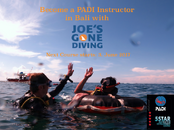At Joe’s Gone Diving we prepare you to be best prepared as a going to be Divemaster or Instructor. Preparation is everything if you want to be a successful Divemaster or Instructor. These days it is not enough just doing briefings and jump into the water. You want to stand out and be one step ahead of your competitors. This is a guide to be best prepared so your students or customers have their best and safest day possible.
Before the dive day:
When does it start? Basically the day before the trip or the course, by opening your Instructor Manual which you’ll get upon your first day as a Divemaster Candidate. This is your rule book which tells you if and how you can conduct fun dives or training dives with all required standards and ratios. This will help you determine which dive site you going to choose or how many or if any assistant’s you going to need. Also you have some guidelines on what required equipment you going to need. For Courses specifically you will also need your PADI Guide to teach and your PADI speciality outlines. Those are all guides you'll need to teach everything according to standards as a PADI Open Water Scuba Instructor and Speciality Instructor.
Dive Day step one:
On the actual dive day the first thing you want to make sure is to have plenty of time before your students/customers arrive. The best thing to do is making a checklist for equipment and other logistical items like water, towels, trip money, safety equipment etc. here little example:
Dive equipment
- Fins
- Boots
- Mask
- Snorkel
- Wet suit
- BCD
- Regulator
- Computer
- Emergency O2
- First Aid Kit
- Emergency Action Plan
- Telephone
- Dive Buoy
- Fin and Mask strap
- Spare regulator
- Spare Mask
- O-Rings
- Diver tool
- Spare BCD
- Spar Weights
- Compass
- Reel
- SMB
- Stage Tank
- Nitrox Analyser
- Knife
- Whistle
- Mask defog
- Fish ID slates
- magnifying Glas
- Pointer
- Dive light
Prepare all the paperwork necessary below a little guide for fun divers, entry level courses and continuing education courses:
Fun Diving
- Registration Form and Rental equipment agreement
- Non Agency Disclosure and Acknowledgment agreement
- Liability Release and Assumption of Risk agreement
- Standard Safe Diving Practices Statement of Understanding
- Registration Form and Rental equipment agreement
- Open Water Diver Record Form
- Medical Statement
- Liability Release and Assumption of Risk agreement
- Registration Form and Rental equipment agreement
- Continuing Education Administration Document
- Appropriate Adventures in Diving, Speciality, Rescue or Divemaster Record Forms
Step Three Special preparations:
Up to step three most divecenters are doing more or less the same. The next tips Joe has to offer will make you stand out on briefings, guiding and teaching in and out of the water.
- To make your bus briefings a little bit more interesting, prepare some slides with fun facts according on what students or customers you have. For example you could talk about how to be proper weighted or give a few fun facts about fish. You can talk almost about everything to make a bus ride or a boat trip more interesting for your customers.
- To get your dive briefings a little bit more interactive bring some dive maps to be able to guide them thru the dive while pointing it out on a map or if you are creative bring a small whiteboard and draw while you are talking. Also a good Idea here is to have some fish slates to point out what you going to see.
- For underwater to get your students buoyancy better bring some toys like little underwater torpedoes and do some buoyancy games. also for experienced divers it is good fun to do so while doing their safety stop.
- To make the fun dive more memorable maybe bring a little go pro and make a few pictures with them to tag them later on social media. This is a very nice one to stay in contact with your students and they will have an amazing memory about diving with you in Bali.
- Bring a fish book, what is better then to discuss the dive and what you’ve seen on it with some fruits while logging dives.
More on being a role model and how to present yourself on our next Blog for being a Divemaster or Instructor at Joe’s Gone diving in Bali





